Headlines
- Rafael will continue west and eventually turn southwest, steered by high pressure over Florida and the northeast Gulf.
- Rafael unlikely to cause serious land problems at this point for Mexico or the U.S. Gulf Coast.
- Higher tides are likely for Texas and perhaps Louisiana, but as we explain below, they will fall well short of levels seen during Alberto earlier this season.
Hurricane Rafael doing some unique things for November
Hurricane Rafael is motoring along this morning in the Gulf of Mexico off to the west and west northwest.
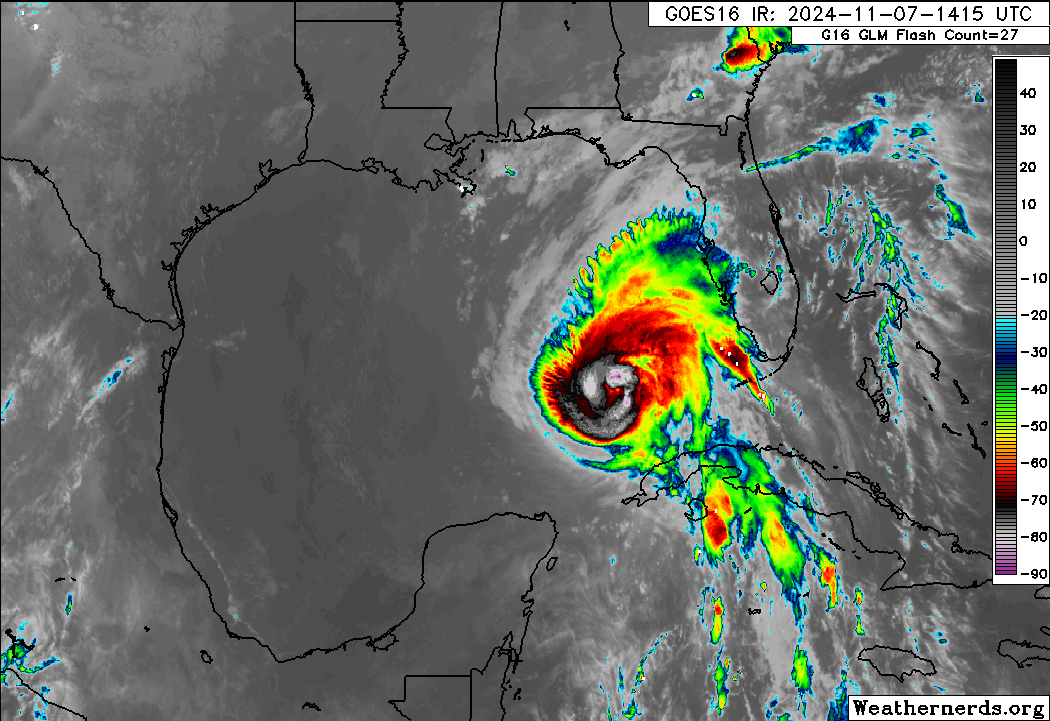
Rafael is a category 2 hurricane with 100 mph winds, down a bit from its peak on approach to Cuba yesterday. It will likely hold steady or gradually weaken in the next couple days as it tracks west.
A storm tracking west in the Gulf is not uncommon. However it is virtually unheard of in November.
Only Hurricane Jeanne in 1980 tracked west in the Gulf in November, and interestingly, it followed a very similar path to Rafael, just farther west of Cuba and then died off before getting to Texas or Mexico. Hurricane Juan in 1985 also had a noteworthy track in that it did several loops over the northern Gulf before eventually making a final landfall near Pensacola. But most Gulf storms in November come due north or track northeast out of Central America as weakened systems. Rafael will definitely be a historically noteworthy system.
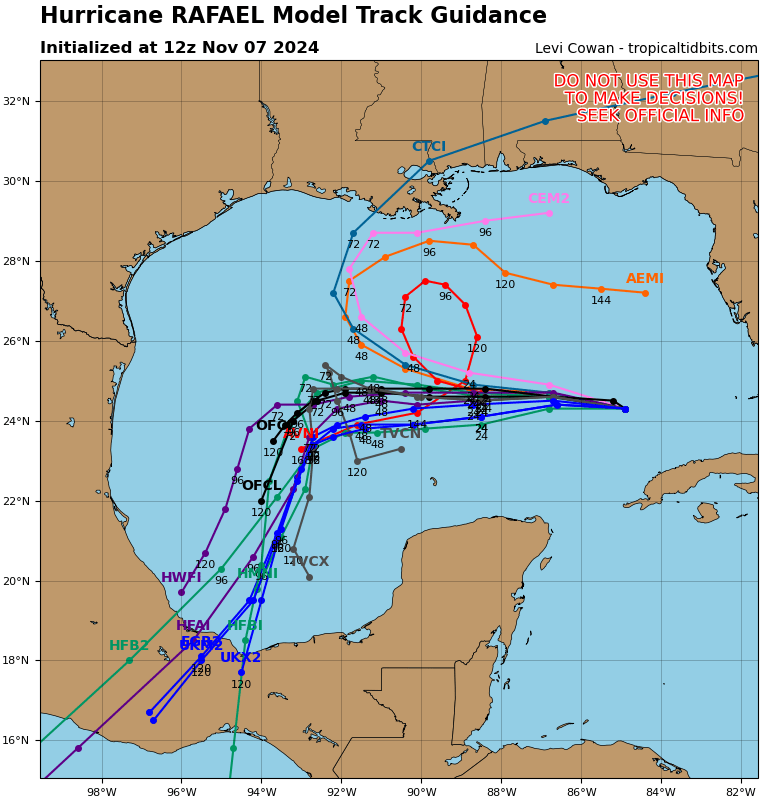
Model guidance is actually in decent agreement today that Rafael will track due west and then inexplicably southwest into the Bay of Campeche. I want to tackle two questions here. First, what in the <redacted> is happening here? Second, someone asked why this storm is not as concerning as Tropical Storm Alberto, which did something kinda sorta similar back in June and caused some considerable coastal flooding on the Texas coast. The two questions are somewhat related.
So, the what is fairly simple to explain. If we look at a map of the upper air pattern, or what will steer Rafael at 48 hours when that turn to the southwest begins, we see high pressure over Florida and the Southeast pushing Rafael to the west.
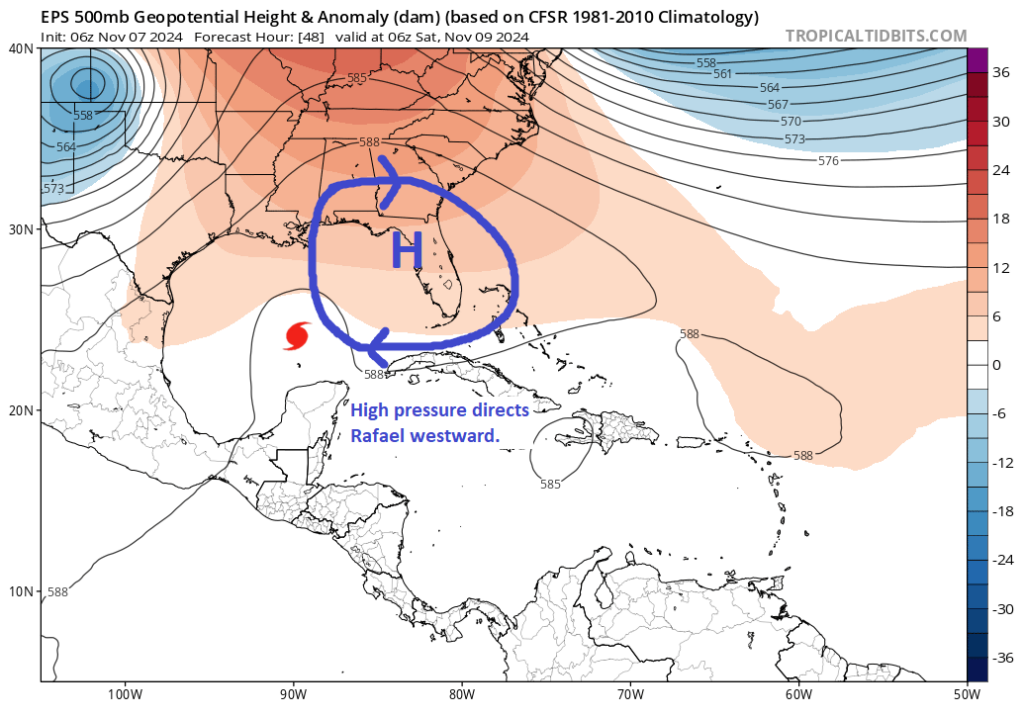
By Monday morning, the high pressure center has moved east of Florida, but it has also kind of strung itself out more. This imparts more of a northeast to southwest type of motion on Rafael. Keep in mind that during this time, Rafael will continue to slowly weaken, so it will also become more susceptible to these steering currents as well, making it easier to sort of “bully” the system into the Bay of Campeche.
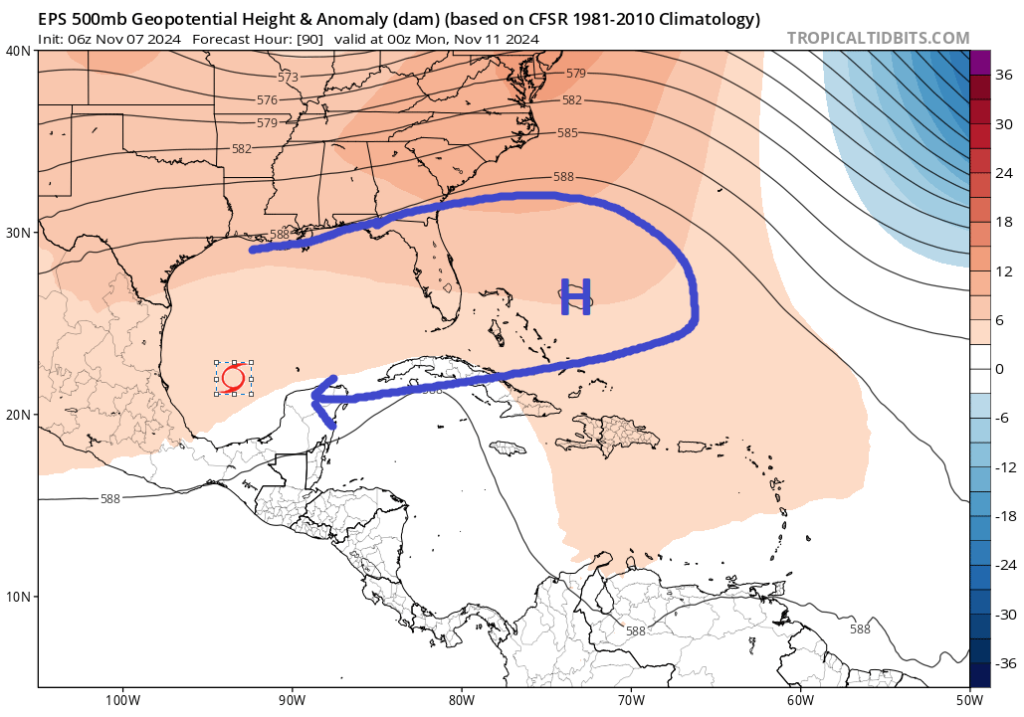
Is this a threat to Mexico? It seems like it won’t be a real serious threat, but it at least bears some watching to make sure everything behaves as expected.
So this leads us to the second question: Why is this storm not really a major flooding concern for Texas, whereas Alberto was back in June. Here’s what the upper air pattern looked like for that event.
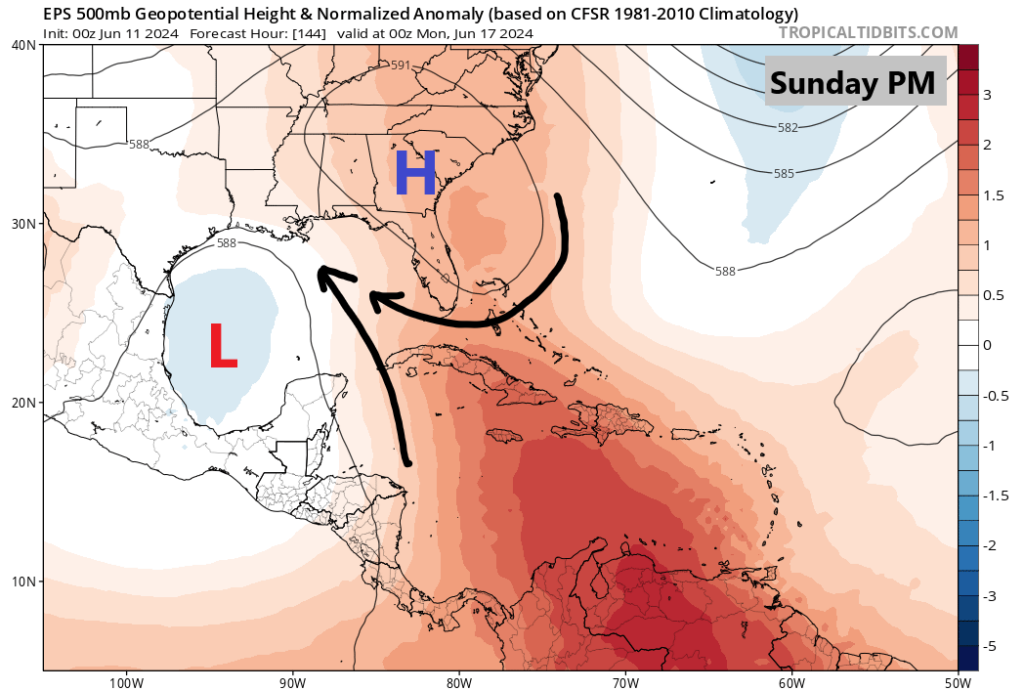
During Alberto, high pressure to the northeast of the Gulf, combined with low pressure in the southwest Gulf led to a broad, strong pressure gradient flow across the entirety of the Gulf. That is what we call a long “fetch,” meaning moisture and waves had an opportunity to pile up in the western Gulf eventually. That led to coastal flooding in Texas and Louisiana. In Rafael’s case, we have the system in the southwest Gulf, but it’s a bit smaller. We also lack high pressure to the north that would enhance Gulf moisture and fetch. Will tides increase on the Gulf Coast? Probably. Will they reach Alberto levels? Almost certainly not. So this is why we aren’t especially concerned about coastal flooding.
Rafael will hopefully be a meaningless blurb by Monday, but we’ll see. Meanwhile. another weak system has a slight chance to develop north of the islands heading into next week. At this point, we don’t view that as a particularly serious concern.
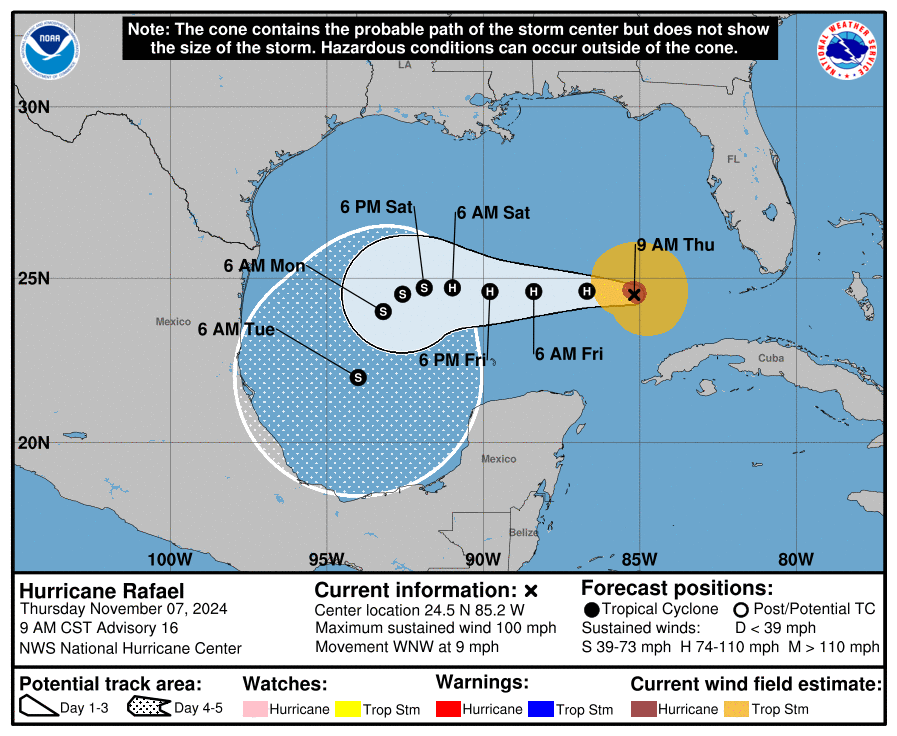
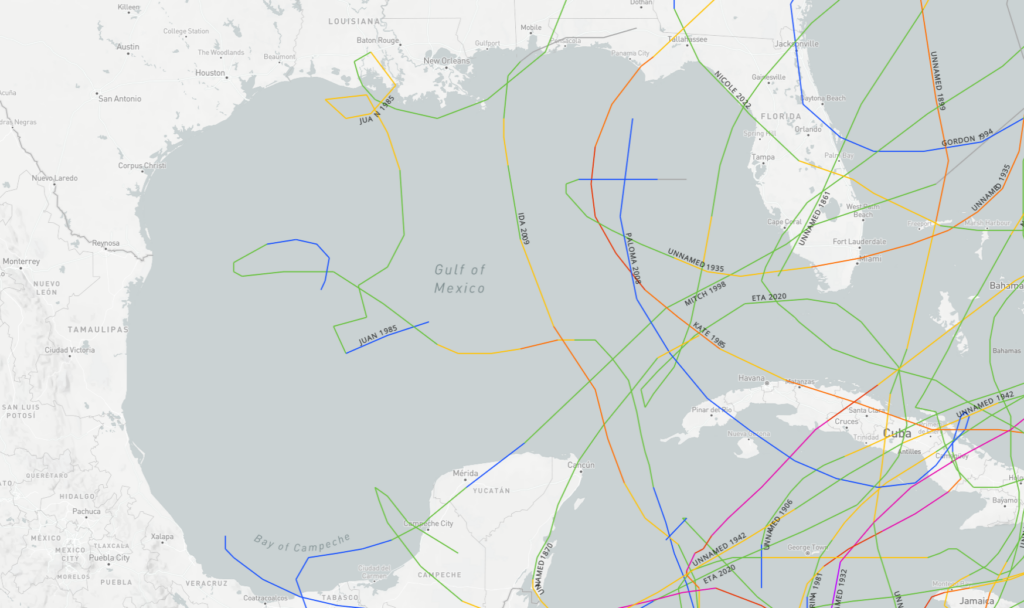
On 19 November 2005, one of our kids was married in Galveston (our home). The week before, or less, there was a hurricane in the Gulf, to the best of my recollection. That is never mentioned. Is my memory that far off on this weather event?
Thanks, Gary
Gary Druss: The only named system at that time was Tropical Storm Gamma, but it was never in the Gulf. It was a Caribbean storm that killed several dozen people from mudslides and flooding in the Lesser Antilles, Honduras and Belize.
Gary: I also meant to say that is probably why you don’t hear anything about it. it was never a hurricane and was never in the Gulf and never a concern here in Texas.
Did you see what Helene did off North Catilina? Don’t think predictions nean much any more.
What are you even talking about? The NHC and NWS predicted catastrophic levels of rainfall in the Appalachians well before Helene made landfall.
What happened in NC was predicted of heavy rain ahead of landfall. The damage came from large amounts of rain coming down from mountains causing major damage
A few days ago nearly all the models were consistent in forecasting a track into the northern GOM with Rafael likely dissipating before making landfall somewhere between the Mississippi Delta and the Florida Panhandle. Did this high pressure system over Florida spring up out of nowhere? How did models and forecasters not see this coming? We don’t often see such a dramatic shift in the forecast track of these storms nowadays.
https://theeyewall.com/wp-content/uploads/2024/11/ecens_2024-11-03-00Z_144_33.942_261.242_12.993_289.63_MSLP_Surface_tracks_lows.png
Looks pretty consistent to me. There were a few outliers that took it towards MS and FL but most kept it on a fairly westward track in the Gulf
This is what I was looking at on Nov. 4:
https://theeyewall.com/wp-content/uploads/2024/11/110424-210050_5day_cone_no_line_and_wind.png
Models and forecasts saw this as a possibility the entire time – the track north into the U.S. or west into Mexico ALWAYS depended on where the storm was after crossing Cuba and how the high pressure ridges developed. The NHC discussion mentioned the split in models and that the cone was a blend of the 2 options, and Dr. Levi (Tropical Tidbits) discussed this big jog in his videos as early as Tuesday. Rafael crossed Cuba to the west of the forecast and the Florida ridge is on the upper end of the predictions – therefore, option 2 it is.
Now it’s headed back to the east as of 7 a.m. this morning.